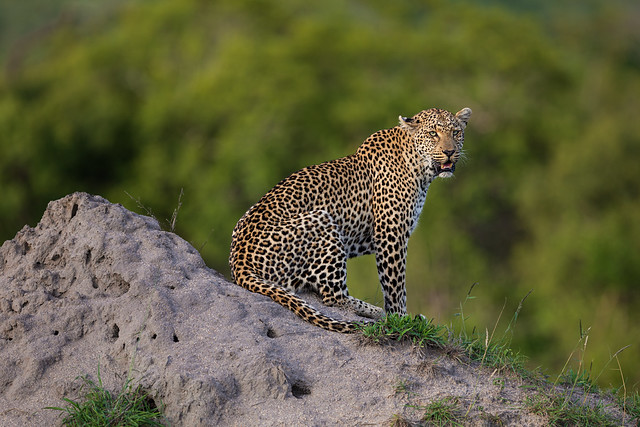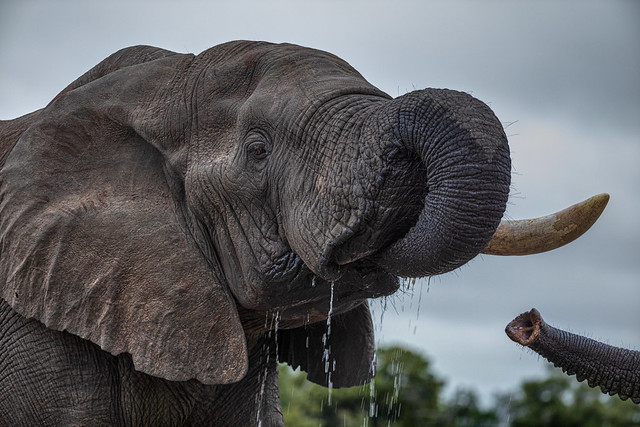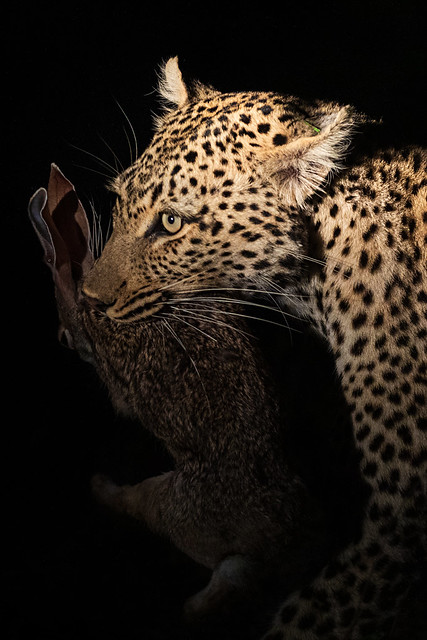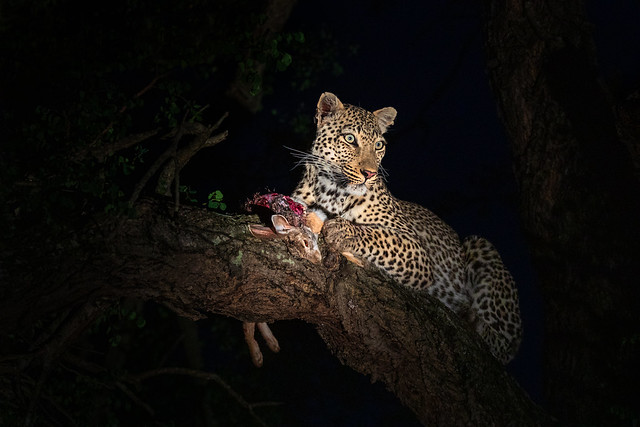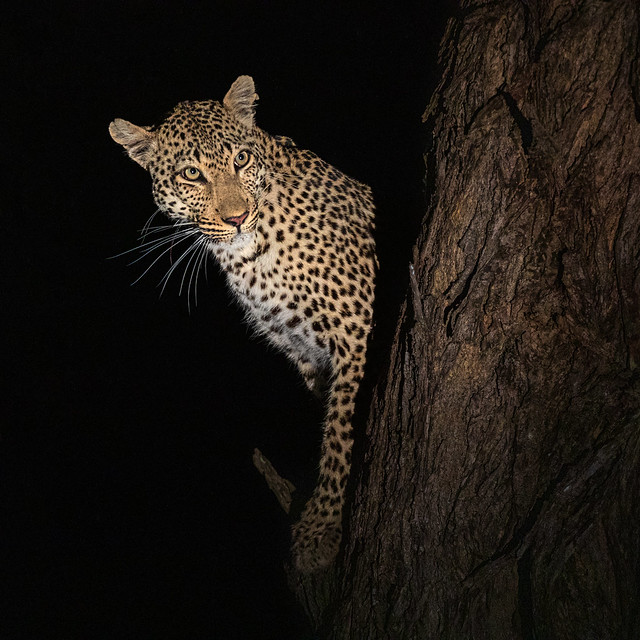Introduction
In my last article, I discussed what makes a great safari.
In this article, I will discuss what makes a great wildlife image.
Firstly, as I discussed in my last article, you need to be in the right place at the right time, which comes down to a combination of planning and sheer luck.
To me, there are four kinds of great wildlife images:
- a frame-filling, up-close facial portrait of an animal;
- an image of an animal doing something interesting, in its natural habitat;
- a combination of a clean portrait and a story; and
- an artistic image.
The four types of images are very different, and have their own strengths.
When I started with African wildlife photography, I wanted the frame-filling portraits, and I captured a few very pleasing images that show a tremendous amount of detail about the animal‘s face, with a smooth, creamy background.
I use a 300mm f/2.8 lens and a 400mm f/2.8 lens for wildlife photography. The long focal lengths and wide apertures allow me to fill the frame with the subject, and blur the background — sometimes almost out of existence.
Combined with the 1.4x and 2x extenders that I have, I can achieve focal lengths of 420mm, 560mm, 600mm and 800mm, and I have used all of these focal lengths for my wildlife images.
The longest focal lengths of 600mm and 800mm have allowed me to achieved some very pleasing images, both by closing the distance and blurring the background.
With birds in particular, I tend to favour the longest focal lengths that I have, as even at short distances, such focal lengths are needed to fill the frame with a small subject.
While I love these kinds of images, they can have their limitations.
The reality is that some images like that could have been captured in zoos. I know this, because I have captured frame-filling portraits in zoos, as well as in the wild. My images captured in the wild could have been captured in zoos, and my images captured in zoos could have been captured in the wild.
There is no context; there is no environment in which the animal is depicted.
The main difference, which is typically seen in images of lions, is that wild lions are not perfect. They engage in battles and permanently carry injuries as a result of their conflicts. Animals that were born in captivity and never had to fight for food, mating rights or territory are picture-perfect and unblemished.
The other difference is that some animals are not found in zoos.
Animal Portraits
I love portraits of wild animals, shot tightly with long focal lengths, filling the subject with the frame, obscuring or obliterating the background, and showing the fine details of the animal‘s face.
One of my favourite animal portraits is this image of the late male lion, Ximpoko.

The King’s Face
I captured this image of Ximpoko during our first safari in Africa, back in 2012. He was also the first male lions that we saw in the wild. He was a very large, heavy lion, and was reputedly the largest male lions in the Timbavati at the time.
This image depicts his detail-laden face, shows his age and experience, and allows the viewer to look right into his intense eyes. We have a large print of this image on our lounge room wall.
Could this image have been captured in a zoo? No. It is clear from Ximpoko‘s injuries that he had encountered numerous battles in his time, and that he was a wild lion rather than a lion in captivity.
Another favourite portrait image was this image of female cheetah Kisaru, captured in the Mara North Conservancy of Kenya during our 2019 trip.
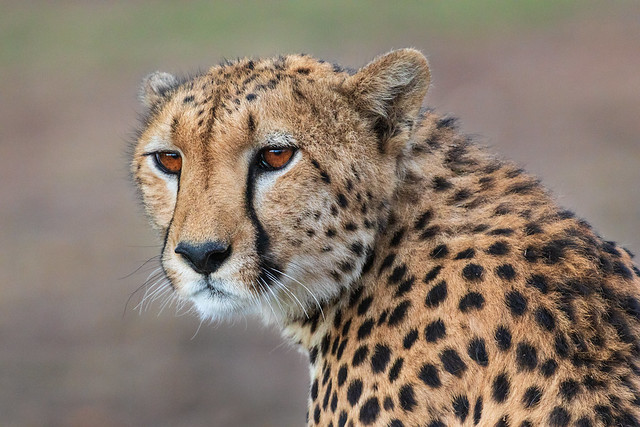
Portrait of Kisaru
In this image, Kisaru dominates the frame, and the soft, late afternoon light accentuates the rich colour of her eyes.
Kisaru was perched on a mound at the time, and the combination of a long 600mm focal length, relatively wide aperture and subject distance allowed for nice background blur.
Could this image have been captured in a zoo? Possibly. Some zoos have cheetahs, but capturing an image like this, depicting a captive cheetah, is not as easy to achieve, given that man-made objects are in abundance at zoos, and lighting conditions such as this are typically not experienced during zoo operating hours.
Another pleasing animal portrait that I captured, again during our first safari, was female leopard Rockfig Jr.

Observation
This is a profile portrait, shot tightly using a 300mm lens wide-open at f/2.8. The relatively long focal length, wide aperture of f/2.8, short subject distance of 7.37m and longer distance between Rockfig Jr and the background allowed me to achieve a very smooth, creamy background, which isolates Rockfig Jr‘s face and eliminates all distracting subject matter in the background.
One of my more recent animal portraits was captured during our most recent trip, in Sabi Sand Wildtuin, South Africa.
It was a very wet morning, and we headed out despite the inclement weather. We spotted several nyalas in the scrub to the side of the road, and I wanted to photograph them.
This is one of the images that I captured:

Nyala in the Rain
I like this animal portrait because not only does the nyala fill the frame, but it is shot in flat, even lighting, has a relatively clean, blurred background, and also shows the relentless rain that we had encountered during that morning.
A particularly pleasing image that I captured our first trip to Kenya in 2015 was this image of a lilac-breasted roller:

Lilac-Breasted Roller
It was late in the afternoon and the light was warm. The subject was perched on a branch, and the rich green colour of the grass in the background was appealing, forming a striking contrast against the subject. Using the 800mm focal length, I was able to achieve a very clean, frame-filling portrait of the lilac-breasted roller.
I have many more animal portraits, but these examples demonstrate the qualities that I like about such images, and make them visually strong and striking.
What they do not do, however, is tell much of a story, or necessarily portray the animals in their natural habitats.
This brings me to the next type of great wildlife image: the story shot.
Story Shots
In as much as I love the clean, frame-filling portraits that I have just discussed, over the years, I learned to capture the story shots. These are the images in which a wild animal is doing something interesting, and in which the animal‘s natural environment is depicted for context.
For a photographer such as myself, who seeks clean images free of distracting or displeasing subject matter, capturing story shots is somewhat harder, because the environment in which something interesting is taking place is not always aesthetically pleasing.
Some of the issues with which to contend are bright areas, messy foliage, branches or leaves obscuring some of the animal, or even random subject matter such as logs, rocks and bushes on the ground, all of which can detract from an image.
It is to be remembered that wildlife photography takes place in nature; the ‘perfection’ and precise control over the scene and lighting, which are easily achieved in a studio environment, simply do not exist in nature.
One must work with what is there, and try to manage it as best as possible by changing positions, focal lengths or composition.
Story shots are far more interesting than portraits, for the obvious reason that they tell a story.
Here are some examples of my story shots in the African wilderness.
During our first trip to Kenya in 2015, we had encountered a large herd of Cape buffalo. I was trying to isolate one buffalo within the herd, which itself was difficult.
What I did not realise while shooting at that sighting in the Mara North Conservancy is that I had captured an interesting image which told a story. I only discovered the image several days later.

Lift Off
I had managed to isolate a buffalo, but I also captured a very interesting moment.
It is a story shot, as it depicts a grumpy-looking buffalo (these animals are very grumpy and very aggressive) which is being constantly pestered by flies and other insects, immersed in a crowd of other grumpy bovines, but most interestingly, with an oxpecker having just launched into flight from the top of the buffalo‘s head.
It is a busy scene, and there are flies everywhere; but it still tells a story of a Cape buffalo‘s existence.
During our first trip to Africa, I was fortunate enough to capture a moment in which two impala bucks were sparring. Impala bucks will engage in battles for dominance and mating rights.
In this image, I captured the clashing of heads.

Headbangers
These two impalas were not engaged in serious battle, but were play-fighting, sizing each other up.
One of the highlights of our Maasai Mara safari in 2015 was the sighting of mating leopards. It was a first-time experience for us, and during the encounter, I captured an image of the female in thick scrub as the male was making advances.

Growl of the Leopardess
This is definitely a story shot, as it depicts the displeased female snarling and showing aggression towards the advancing male. It was not an easy image to capture, as the setting was dark, and the environment in which the female leopard was sheltered was messy and distracting. However, it tells a story, and depicts a moment in time, and a moment in nature.
During our Maasai Mara trip in 2019, there was something in the air, as we saw lots of mating activity.
One particular sighting resulted in a pleasing image which tells a story.

Gimme Some Action
A particularly excited male wildebeest was running around, trying to mate with the females. It was quite a funny sight, as he was all over the place, grunting and trying as best as he could to capture the interest of the resident females.
In this image, I captured him standing at attention on multiple counts!
While I used a 300mm lens for this image, the subject distance was sufficient for the environment to be depicted, with other wildebeest scattered around, and a view of the open plains of the Maasai Mara.
During our Maasai Mara trip in 2019, we were fortunate on one afternoon/evening game drive to have a lengthy and exclusive sighting of female cheetah Kisaru.
We were in the northern part of the Mara North Conservancy, close to the Mara River, and we were on our own, with no other safari vehicles in sight.
It is unusual not to encounter other safari vehicles at a cheetah sighting, but we were fortunate on that occasion.
Kisaru had been resting on a mound, and eventually decided to get up and stretch before moving on.
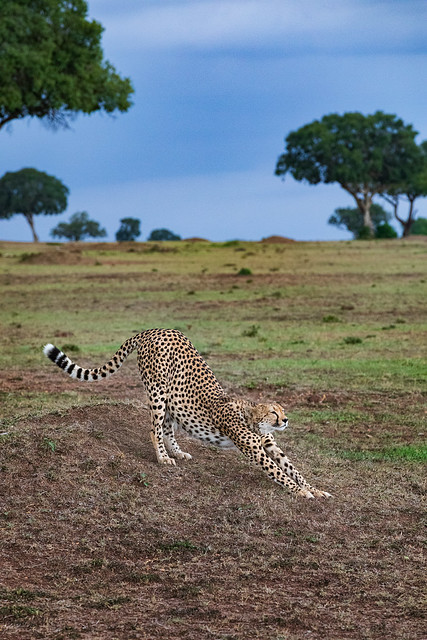
Evening Stretch
This is very typical cat behaviour, and by shooting an interesting moment with a wider focal length, I was able to place Kisaru in her environment doing what she naturally does.
Also during that same trip, we were very privileged on one morning to witness the Offbeat Pride lions feasting on a buffalo that was taken down earlier in the morning.

Table Manners
This image depicts the pride male and one of the pride’s females feasting on their kill, with other lions joining in the pandemonium.
While it is a tightly-framed image captured with the 600mm focal length, it tells the story of a lion pride feasting on a kill, with the male gorging himself and one of the females snarling, with her face messy from the savagery of her feasting.
During our most recent trip, on this occasion in Sabi Sand Wildtuin, we encountered two male zebras fighting.
I have not captured many photos of zebras during our trips to Africa, as while there are plenty of them, most of the time, they do not do anything interesting.
On this occasion, however, two male zebras got into a fierce fight.

Clash
Males fight for dominance and mating rights, and in this image, one of the zebras clearly has the upper hand.
The action was certainly noticed by the impala herd in the background.
I love the action in this image, and the story that it tells. The fighting stallions are in their natural environment, which the image depicts; and the position of the zebras is perfect and visually appealing. It is especially appealing to me because zebras generally do not do much of photographic interest, and I captured a moment that I had never seen before.
One of the most exciting sightings that we have experienced was that of female leopard Makhomsava, who had captured and killed a scrub hare and scrambled up a tree to protect herself and her kill from a hyena that was on the ground at the base of the tree.
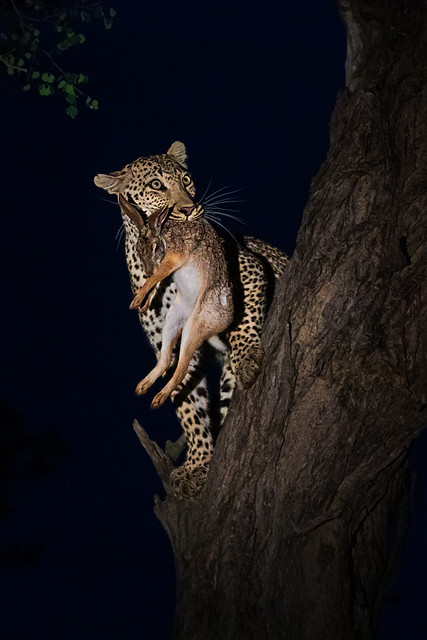
Dinner Time
This image depicts a brief moment as Makhomsava, with her kill in her mouth, standing in the bough of a tree before she quickly climbed higher to safety and began to devour her meal.
The next type of wildlife image combines the qualities of a clean, frame-filling portrait and the story.
Combinations of Clean Portraits and the Story
To capture an image which ticks two proverbial boxes can take it to the next level, and I have been fortunate to have captured several images which exhibit the aesthetic appeal that I desire, as well as the story and the interest.
During an afternoon game drive on our Maasai Mara safari in 2015, we happened across a pied kingfisher bouncing up and down to the side of the road. We stopped for only a very brief amount of time, and I fired the shutter release button on my camera only twice. This was the result of one of those shutter releases:
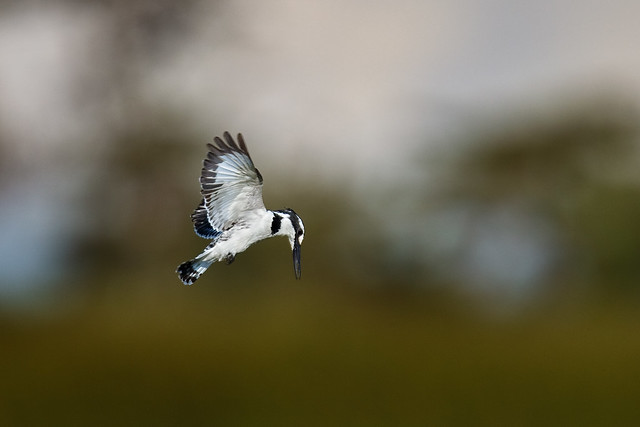
Suspended
This image was the result of pure luck, and depicts the interesting behaviour of the pied kingfisher as it bobbed up and down in the air, whilst set against a clean background which isolates the subject.
Also during that same trip, we were privileged to spend some time with elephants, and I captured two of them engaging in ‘trunk wrestling’.

Trunk Wrestling
Using my 400mm f/2.8 lens wide-open, I was able to get right in close to the action, and capture the story of these two elephants engaging in bonding.
The background is nice and blurry, but it shows the vast plains of the Maasai Mara set against a rich blue sky, while the story of elephants playing and bonding is the dominant, frame-filling element.
One of the more unusual images that I captured was during a trip to the Maasai Mara National Reserve in Kenya during our 2019 trip.

Peekaboo
This image fills the frame with the subject, but most interestingly depicts unusual behaviour. This hyena was hiding in the hollowed trunk of a large tree.
Hyenas are aggressive, dominant predators that rarely show signs of timidness and apprehension, and this particular hyena appears to be vulnerable and frightened, choosing to hide within the hollow tree trunk.
An image that I had long desired to capture was that of an African leopard posing beautifully on a mound in warm light, with a clean background.
It took ten years for me to land such a shot, but I achieved that goal during Sabi Sand Wildtuin trip in 2022.
The star of that safari was a female leopard called Tiyani. As it turned out, we enjoyed five sightings of Tiyani over the seven-day trip, and on the fifth day, the opportunity for a long-desired image was finally realised.
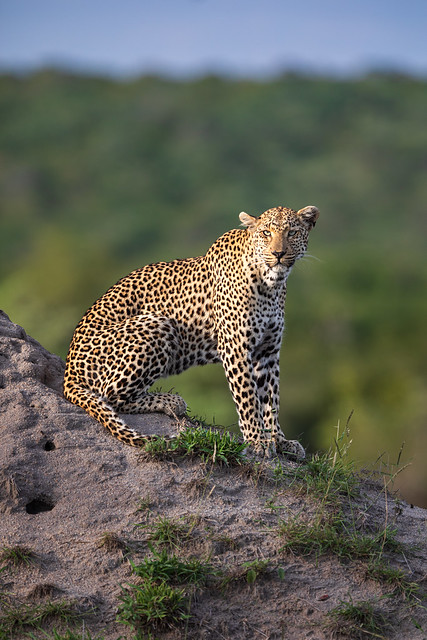
Tiyani Surveying
Leopards love to rest of mounds, and cat, big and small, love height, as it allows them to survey their surroundings.
Tiyani had been located on a mound, and during the warm afternoon light, she posed beautifully on her mound, looking around, and occasionally looking at us.
Finally, I was able to capture an image of a leopard on a mound in warm light, with a clean background.
During the same Sabi Sand Wildtuin trip in 2022, we were privileged to experience several sightings of African wild dogs. These are critically endangered, and we had never seen them in the wild until that trip.
During one great sighting at a dam, I landed this image of one of the African wild dogs of the Ottawa Sand Pack:

You Have My Attention
This image also illustrates the the combined qualities of a clean image with a story unfolding.
This African wild dog had lowered its head and was moving towards whatever captured its attention. It shows the behaviour of African wild dogs that are in hunting mode, whilst being isolated against the background and shot from a low angle.
Artistic Images
The final type of image that I consider to be a great wildlife image is the artistic image. Such images depict a strong subject in its natural environment, but take on a more artistic aesthetic.
In my experience, an affective way of achieving such an image is to depict the subject in silhouette.
During our Maasai Mara safari in 2015, we headed south to the Maasai Mara National Reserve. On the way, early in the morning, we saw some distant giraffes.
We decided to capture what was unfolding in front of us. A mother and her calf were strolling across the Mara plains, and rays of sunlight were streaming through the cloud-land sky.
Here is the image that I captured:

Wait for Me, Mum!
To me, this image has all of the elements of a great artistic wildlife image. Furthermore, it combines a frame-filling subject, a great story, and an artistic aesthetic.
Several years later, back in the Mara, I again employed the use of silhouette to depict female cheetah Kisaru against the rich sky as the sun was setting.

Kisaru in Silhouette
Other Considerations
I have presented a range of my African wildlife images from what I consider to be the four categories of great wildlife images.
However, no matter what type of image is desired, there are various factors to take into consideration.
Firstly, there is the light.
The most appealing wildlife images are captured early in the morning, or late in the afternoon, which are the times during which the sun is low in the sky, resulting in warm, appealing light, and avoiding the glary, bleached conditions and harsh shadows of broad daylight.
The quality of light during the periods of twilight that begin and conclude the day also make for great wildlife images.
Not only are the early and late hours of the day the most visually appealing, but they are also the times during which animals tend to be more active.
The next consideration is angles.
Sometimes, it is literally a matter of inches between a good image and a great image. Changing one’s position ever so slightly can really make a difference.
One of the most important angles is the vertical angle. In safari vehicles, photographers are positioned higher, which means that most of the time, they are looking down on the animals. A downward-facing angle is not very appealing, and the more pleasing wildlife images are captured from the animal‘s height.
Unfortunately, this is not always possible; but depending on the environment, it may be possible to be positioned higher or lower, in line with the subject.
One way of achieving this is by using distance. The greater the distance, the less pronounced is the height difference between the photographer and the subject. Of course, a greater distance between the photographer and the subject means that longer focal lengths are needed in order to close the gap and make the subject more prominent.
Horizontal angles are important, too. Consider the position of the sun. Great wildlife images can be captured from various angles relative to the sun. Shooting into the sun is one option, and can result in rim lighting around the subject. Shooting into the sun also allows the subject to be depicted in silhouette.
Side lighting reveals shape and form and can make a three-dimensional subject actually look three-dimensional in a two-dimensional image.
The next consideration is focal length.
Various focal lengths from ultra-wide to very long telephoto can be used to great effect in wildlife images.
Wildlife photography is typically the domain of long lenses, with focal lengths from 300mm to 800mm. Longer lenses are used primarily due to distances from the subjects. Sometimes it is not possible to be close due to the wildlife being dangerous, skittish or otherwise impossible to be near due to environmental factors such as rugged terrain or water. Some kinds of wildlife is small, and the difficulty is compounded by some small fauna being flighty.
Additionally, it is necessary to maintain a healthy distance out of respect for the wildlife. While it may be possible to get close, it is not necessarily a good idea.
Other than the ability to close the distance between the subject and the photographer, the use of long focal lengths also allows the subject to occupy most or all of the frame. I earlier discussed the kinds of frame-filling portraits that I like to capture, and these were all captured with longer focal lengths.
However, the use of long focal lengths can sometimes be a disadvantage. If an animal is being photographed from a distance with a long focal length, and that animal decides to move towards the photographer, the opportunity for an image may be lost.
This has happened to me several times.
On one occasion, I was using my 400mm lens to photograph a lioness in the Mara North Conservancy of Kenya. She was out in the open, and the warm sun was behind us. The lioness saw an opportunity to seek some shade from our vehicle, and walked right towards us, stopping outside the 4WD, at which point she looked right at me. My 400mm lens was quite useless at that point!
More recently, we were photographing a large elephant bull in the rain in Sabi Sand Wildtuin, South Africa. While we had distance from the elephant, the elephant was constantly on the move, and kept closing the gap between us, which meant that I could not depict the whole elephant within the frame. Consequently, we had to drive away and re-position ourselves so that the elephant was further away, giving us time to compose our images.
Wider focal lengths can be very handy when an animal is close, but wider focal lengths can also be used to great effect to position an animal in its natural habitat, which aids in telling the story. Depicting an animal with less prominence in the frame, but within the context of its environment, can result in a stronger image.
In addition to focal length, the aperture of a lens is an important consideration. Wide apertures have multiple benefits: they allow for subject isolation, smaller depth of field, shorter shutter speeds and easier composition and visibility before capturing the image.
As a lot of wildlife photography can be conducted in low light or other darker conditions, wide apertures are very beneficial.
Finally, an important consideration is shutter speed.
There is nothing more useless than a wildlife image in which the subject is unintentionally blurred. A sufficiently fast shutter speed is necessary in order to ensure a sharp image, particularly when the light is low, or when the subject is moving, or worse: both.
The use of longer focal lengths, which magnify both subject and photographer movement, requires faster shutter speeds. Combined with low light and subject movement, it may be necessary to increase the ISO rating of the camera so that a suitably fast shutter speed can be maintained for the conditions.
Light, angles, distances, focal lengths, apertures and shutter speeds can all be used, both singularly and in combination, to achieve great wildlife images. Sometimes adjusting some or all of these attributes is necessary in order to overcome a technical challenge; and at other times, these attributes can be used creatively for a desired aesthetic or story-telling effect.
Conclusion
Throughout this article, I have outlined in words and images what I consider to be four kinds of great wildlife images. In addition, I have outlined some other factors that need to be taken into consideration for creating great wildlife images.
For me, the never-ending pursuit of creating great wildlife images will continue, but not soon enough!
























